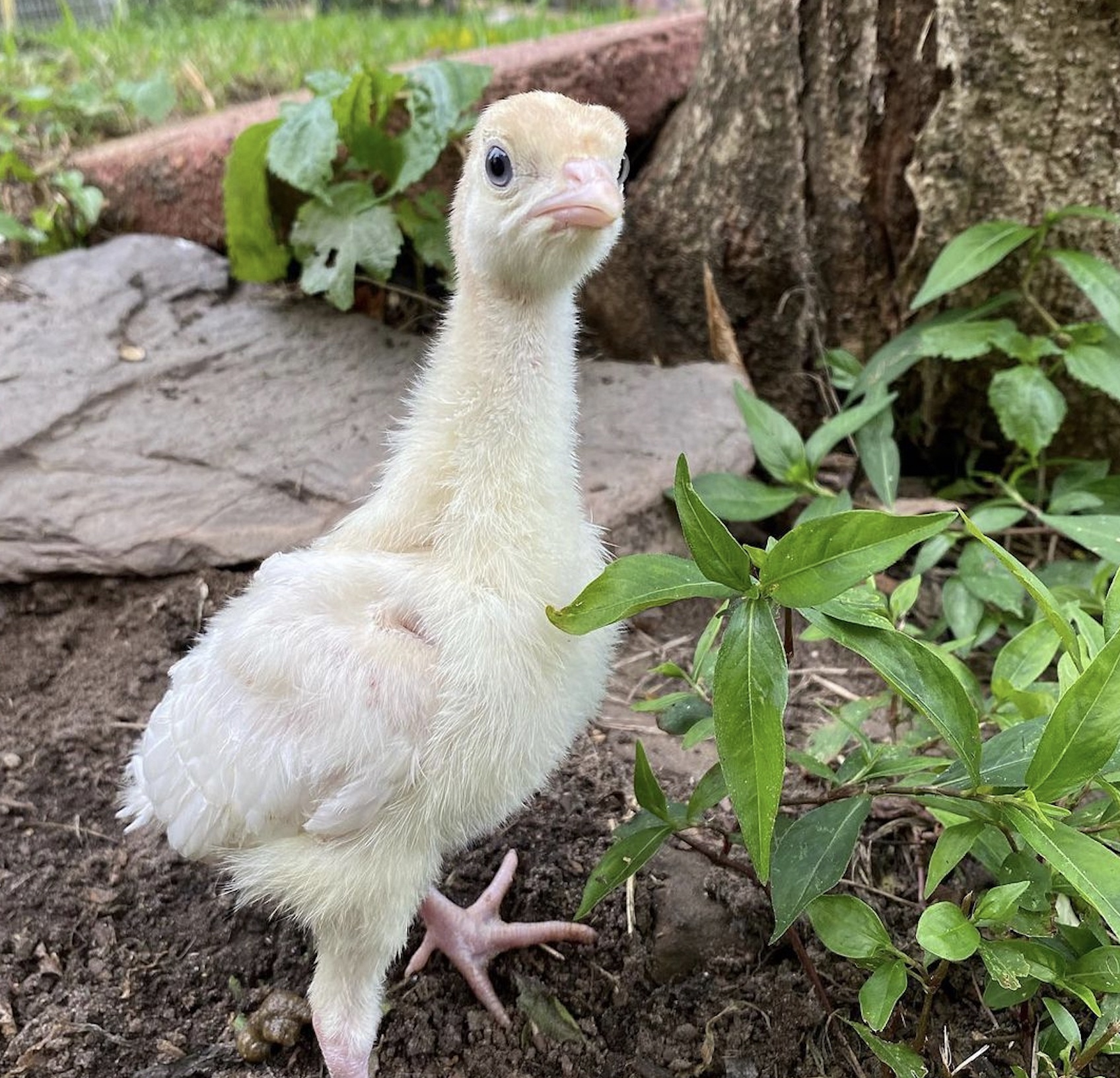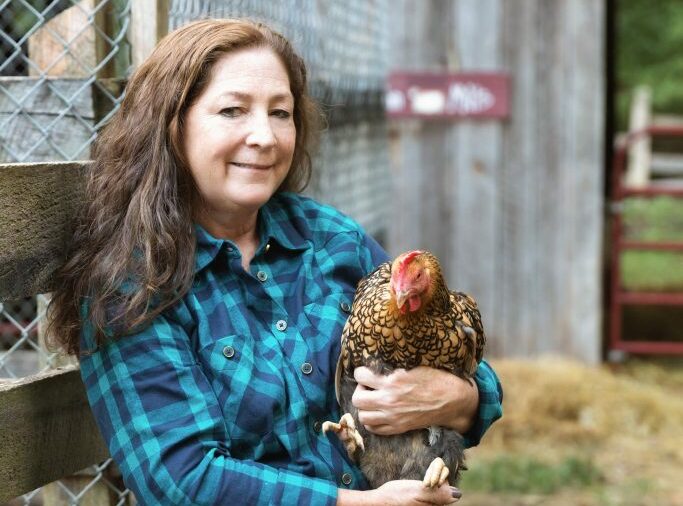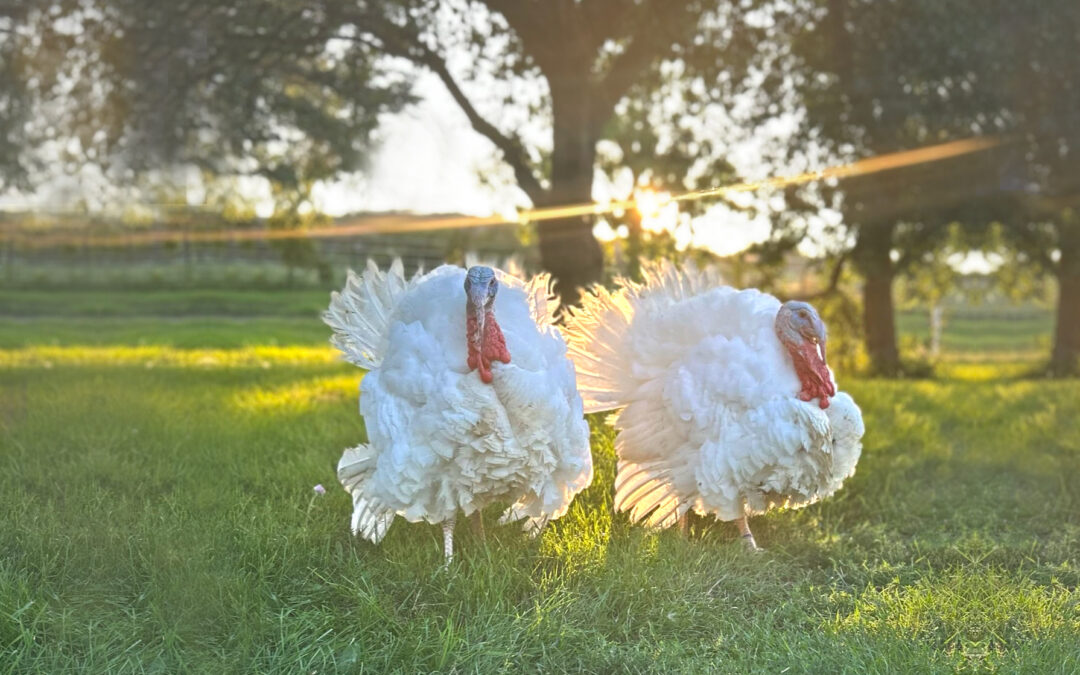The Midget White turkey breed was new to me last season. I had never heard of them at all before spying them in Murray McMurray’s annual catalog last year. In fact, I wasn’t even sure that I wanted to try raising turkeys again after the first time.
Years ago, when we were quite inexperienced at poultry keeping, we dipped our toes into raising turkeys. Our first breed was the Narragansett, a Heritage breed that is sought after for its flavor and growth. Sadly, we were not actually prepared to raise turkeys. They didn’t get along with chickens or ducks, probably because there wasn’t enough space for adding them. Predators nixed the free ranging option, and they were relegated to a pen and coop that wasn’t large enough. After sharing the batch with neighbors and friends, we kept only two.
Murray’s Midget White Turkey: Getting Started
Decades passed. We now have a large poultry yard with several coops and fenced in poultry runs for safety in our wooded environment. Over the years, we have raised various animals for meat on our farm, except poultry. We had never raised poultry for meat again after that one trial. I knew it was time to try again now that we were better prepared.
I read about the smaller turkeys being offered by Murray McMurray Hatchery, and thought one would be a good fit for us. Their smaller Heritage breeds include the Heritage Midget White and the Royal Palm. For production breeds, both Murray’s Artisan Black and Murray’s Midget White turkeys are great options.
I ordered six of Murray’s Midget White turkeys along with my yearly order of a dozen layer pullets. We also added a dozen guinea keets to work on the tick population, too.
The birds arrived late in July after hatching and shipping. Everyone was robust and healthy! Out of all the birds, we did lose one small chick the first week. Other than that, everyone thrived.
For the first several weeks, the birds were fed a local organic, whole grain, feed mixture for mixed flocks. I did seek some advice after a few weeks and decided to switch the turkey poults and guinea keets to a game bird starter. The problem was we only had one large brooder suitable for two dozen plus growing birds. The birds had access to both the original starter ration and the game bird starter.

Choosing a Turkey Variety: A Tip from an Expert
 A Thanksgiving table’s centerpiece is the turkey, which makes selecting the correct turkey variety to raise important. Two questions you should ask yourself when picking the turkey breed you wish to raise are:
A Thanksgiving table’s centerpiece is the turkey, which makes selecting the correct turkey variety to raise important. Two questions you should ask yourself when picking the turkey breed you wish to raise are:
- Would you like to raise a Heritage breed that takes longer to grow-out but is naturally full in flavor, making it unnecessary to brine the bird?
- Or, would you prefer a larger production variety that consumes less feed and has a faster grow-out time?
Once you make the first decision between Heritage and production turkeys, you’ll be more equipped to learn about their individual needs and timelines before picking a specific breed to raise.
— Ann Accetta-Scott, A Farm Girl in the Making
Murray’s Midget White Turkey: The Grow Out Period
McMurray recommends growing their Murray’s Midget White turkeys out for about 20 weeks, but their timeline can be more flexible than other traditional production breeds. I f you have raised turkeys before, you will agree that there comes a point in the growth chart where they eat everything and grow extremely fast!
At one point, it was clear that the turkey poults were outgrowing their time with the little chicks. A larger coop with a fenced run was cleaned up and readied for the new residents. It was late September, and the birds were just under 10 weeks old. I settled them in one day and watched the growth continue.
The fall is a busy season for us, not only on the farm but with our businesses too. I was getting everything in order as butchering day approached. A call to McMurray Hatchery’s customer service gave me the assistance needed. By this point in time, I was fairly certain that we would be continuing on with meat birds of some sort, so I opted to purchase new equipment for butchering day. Everything arrived and we were ready to set a date for butchering our turkeys. I also knew I wanted a mentor on hand to teach me since I hadn’t had much experience in the past, so I invited a friend to help too. Due to scheduling, we did not wait for twenty weeks. The turkeys were a respectable size, although I wasn’t sure how much they weighed.
Murray’s Midget White Turkey: Processing Information
Supplies:
-Large table covered in heavy plastic sheeting
-Two large bins of ice water
-Extra-large plastic poultry bags, twist ties or zip ties (Note: we double bagged all the birds)
Processing Day
With three people working, it took us about four hours. We started at 9am on a chilly morning. The scalder was struggling to heat up. We lost two hours of the day trying to get the scalder hot enough to dip the birds. Finally, we heated water to a simmer on a camp stove and poured it into the scalder. A piece of plywood was used to keep the heat in the scalder from cooling off.
The birds were all extremely easy to handle, both growing up and on butchering day. This breed seems to be exceptionally docile. I had cared for them each day and they seemed to not be concerned about my presence. For each, I simply walked into the run and picked one turkey up, carrying it to our processing area.
Final Weights
Our flock of turkeys consisted of five toms and one hen. Even though we didn’t raise them the full 20 weeks, their final weights were still quite good. The hen dressed out at 10 pounds. On the small side, but perfect for my friend who helped. The toms weighed in between 15 and 17 pounds, which was the perfect size for our family’s needs.

Murray’s Midget White: The Perfect Family Table Bird
Not waiting for the turkeys to gain a few more pounds was a good decision, looking back. We are a household of two people. We did use one turkey for Thanksgiving, but we also serve ham and all the side dishes. Using a 15-pound turkey was just the right size for our family gathering of ten. We had leftovers, but nothing crazy, and the turkey bone broth and soup used up the scraps.
The most important factor when raising meat birds is taste! I was very pleased with the flavor. No bland turkey for us. These birds were tender, juicy, and with a flavor that is hard to describe, although extremely good. One of the tenets we adhere to when raising our own meat is not wasting anything. I can assure you that I had no trouble using up every scrap of turkey meat, the bones for broth and a large pot of soup. The bones are now in the garden, nourishing our soil for next summer’s vegetables. The feet are in the freezer. We loved raising this breed, and will certainly do it again!

Janet Garman of Timber Creek Farm is an author, fiber artist, and farmer with a love for animals and sustainable living. Janet has a degree in large animal farm management and animal science from the University of Maryland, and helps others learn to raise livestock, chickens, ducks, rabbits, and manage a small farm. Her articles on keeping animals, small farms, and homesteading can be found on many popular websites. Janet is the author 50 Do-it-Yourself Projects for Keeping Chickens, Chickens from Scratch and many books about fiber arts and farming with animals.
Featured photo courtesy of Lisa Carter. Blog photos courtesy of Janet Garman.

